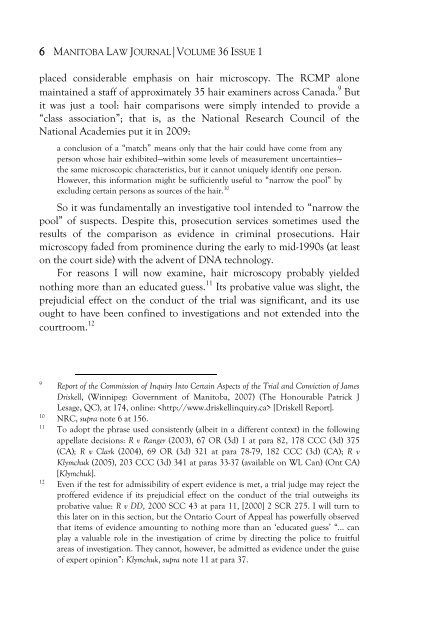Wrongful Convictions.pdf - Robson Hall Faculty of Law
Wrongful Convictions.pdf - Robson Hall Faculty of Law
Wrongful Convictions.pdf - Robson Hall Faculty of Law
You also want an ePaper? Increase the reach of your titles
YUMPU automatically turns print PDFs into web optimized ePapers that Google loves.
6 MANITOBA LAW JOURNAL|VOLUME 36 ISSUE 1placed considerable emphasis on hair microscopy. The RCMP alonemaintained a staff <strong>of</strong> approximately 35 hair examiners across Canada. 9 Butit was just a tool: hair comparisons were simply intended to provide a“class association”; that is, as the National Research Council <strong>of</strong> theNational Academies put it in 2009:a conclusion <strong>of</strong> a “match” means only that the hair could have come from anyperson whose hair exhibited—within some levels <strong>of</strong> measurement uncertainties—the same microscopic characteristics, but it cannot uniquely identify one person.However, this information might be sufficiently useful to “narrow the pool” byexcluding certain persons as sources <strong>of</strong> the hair. 10So it was fundamentally an investigative tool intended to “narrow thepool” <strong>of</strong> suspects. Despite this, prosecution services sometimes used theresults <strong>of</strong> the comparison as evidence in criminal prosecutions. Hairmicroscopy faded from prominence during the early to mid-1990s (at leaston the court side) with the advent <strong>of</strong> DNA technology.For reasons I will now examine, hair microscopy probably yieldednothing more than an educated guess. 11 Its probative value was slight, theprejudicial effect on the conduct <strong>of</strong> the trial was significant, and its useought to have been confined to investigations and not extended into thecourtroom. 129Report <strong>of</strong> the Commission <strong>of</strong> Inquiry Into Certain Aspects <strong>of</strong> the Trial and Conviction <strong>of</strong> JamesDriskell, (Winnipeg: Government <strong>of</strong> Manitoba, 2007) (The Honourable Patrick JLesage, QC), at 174, online: [Driskell Report].10NRC, supra note 6 at 156.11To adopt the phrase used consistently (albeit in a different context) in the followingappellate decisions: R v Ranger (2003), 67 OR (3d) 1 at para 82, 178 CCC (3d) 375(CA); R v Clark (2004), 69 OR (3d) 321 at para 78-79, 182 CCC (3d) (CA); R vKlymchuk (2005), 203 CCC (3d) 341 at paras 33-37 (available on WL Can) (Ont CA)[Klymchuk].12Even if the test for admissibility <strong>of</strong> expert evidence is met, a trial judge may reject thepr<strong>of</strong>fered evidence if its prejudicial effect on the conduct <strong>of</strong> the trial outweighs itsprobative value: R v DD, 2000 SCC 43 at para 11, [2000] 2 SCR 275. I will turn tothis later on in this section, but the Ontario Court <strong>of</strong> Appeal has powerfully observedthat items <strong>of</strong> evidence amounting to nothing more than an ‘educated guess’ “… canplay a valuable role in the investigation <strong>of</strong> crime by directing the police to fruitfulareas <strong>of</strong> investigation. They cannot, however, be admitted as evidence under the guise<strong>of</strong> expert opinion”: Klymchuk, supra note 11 at para 37.














